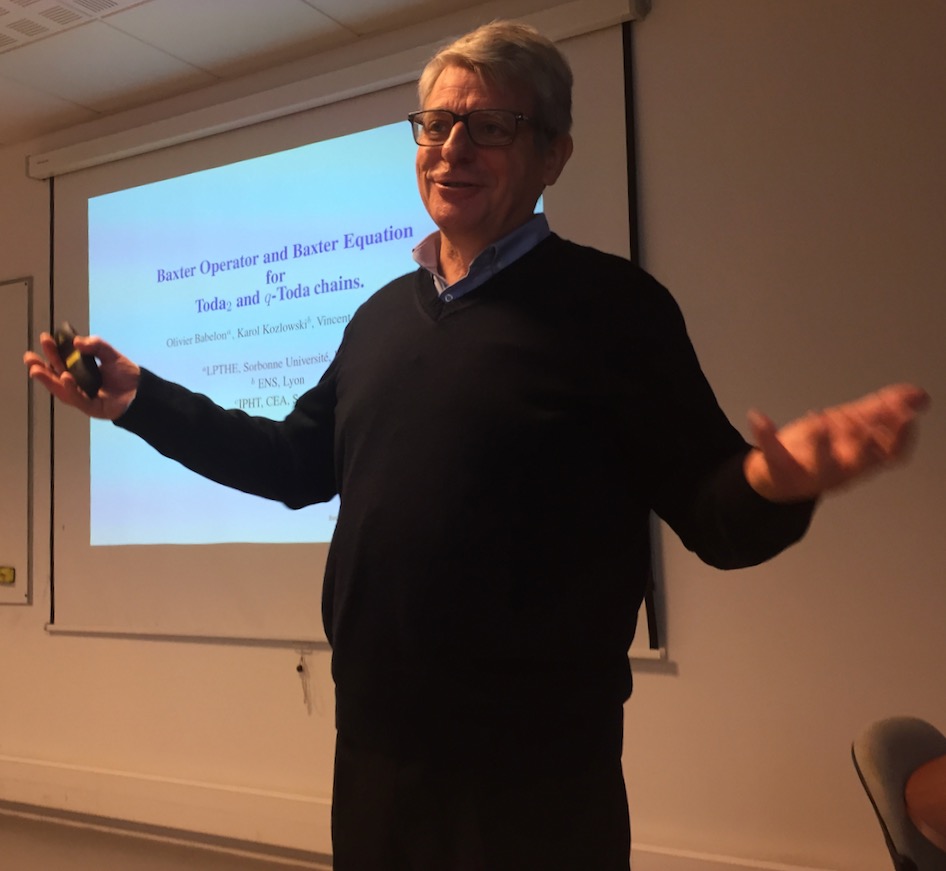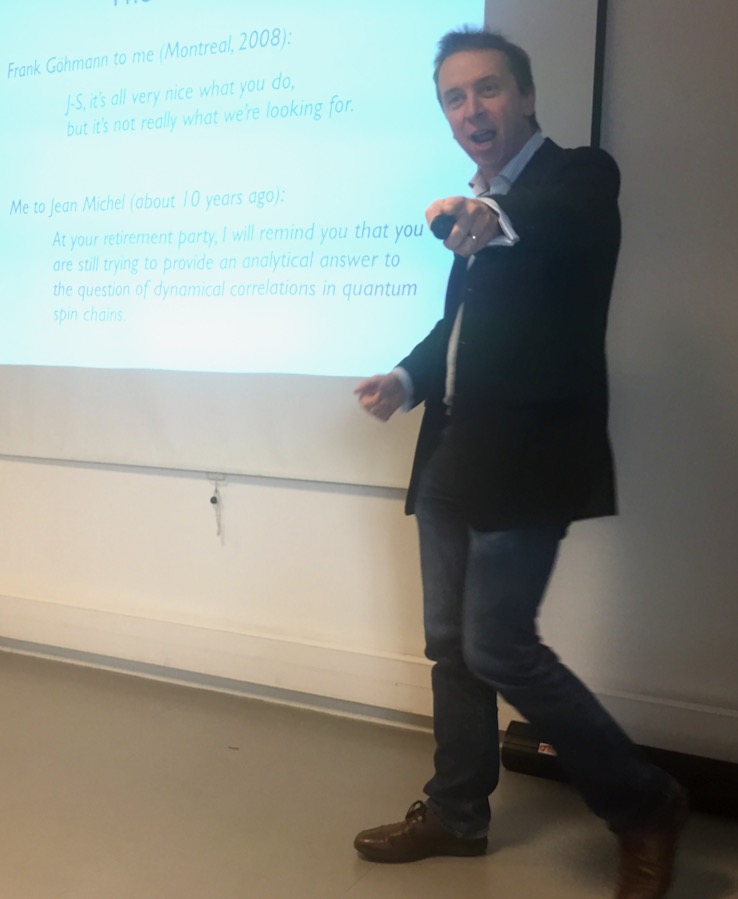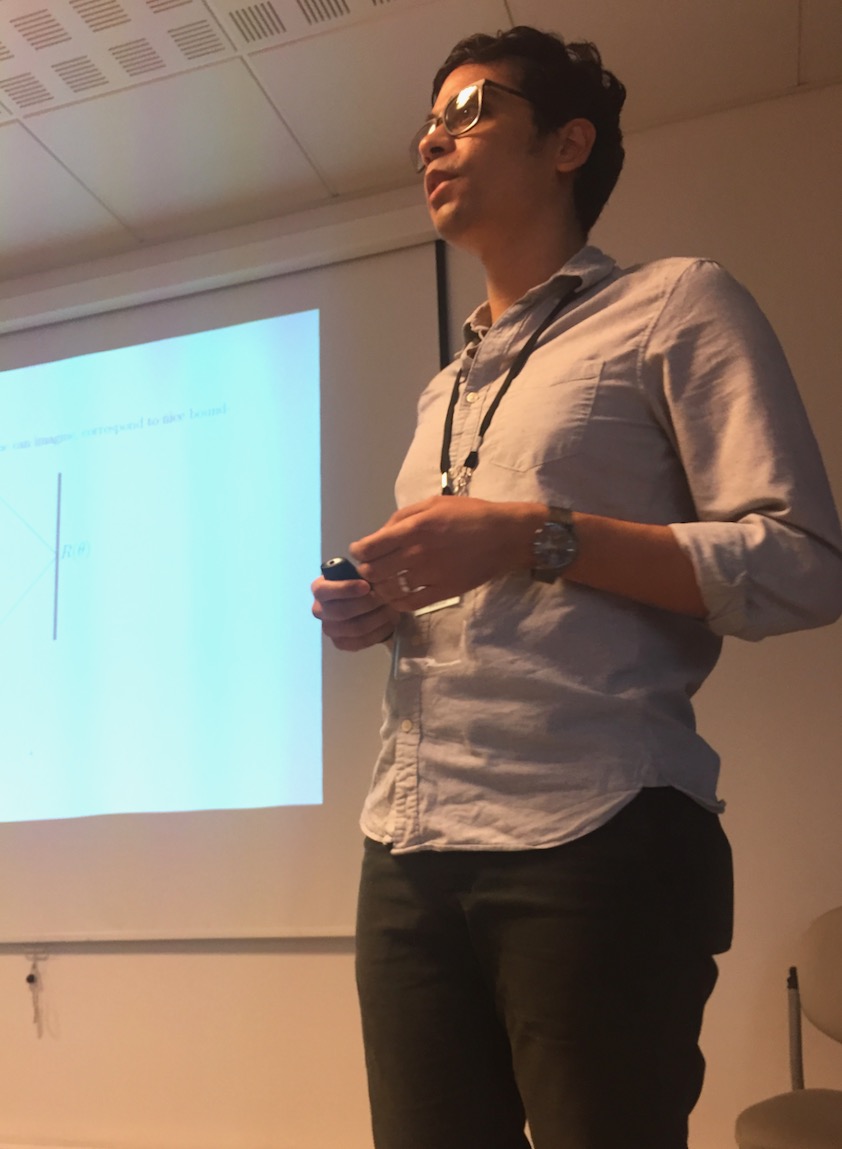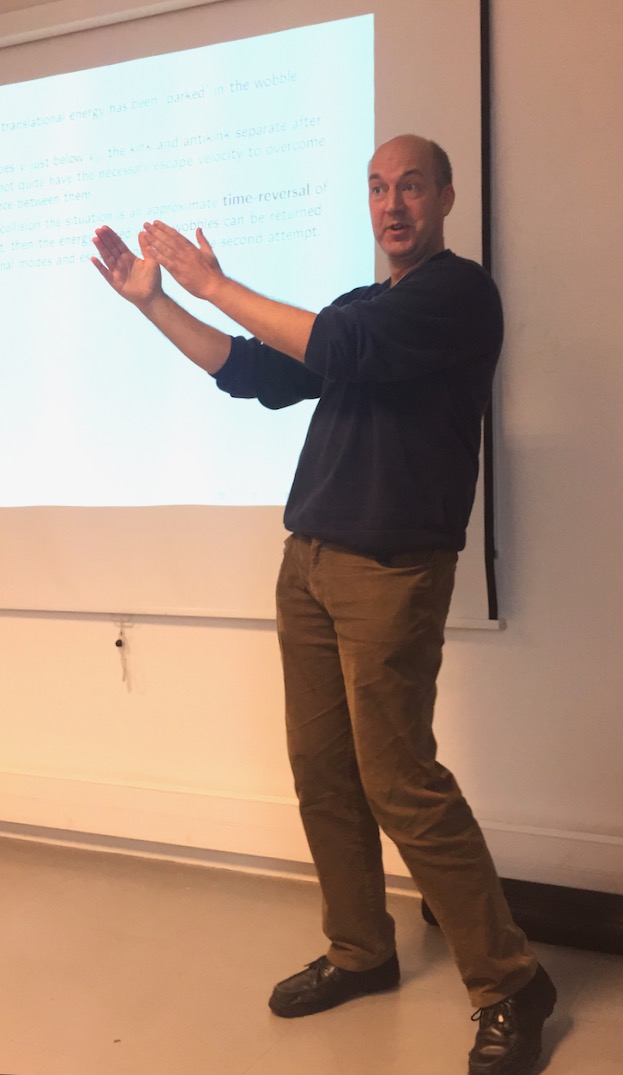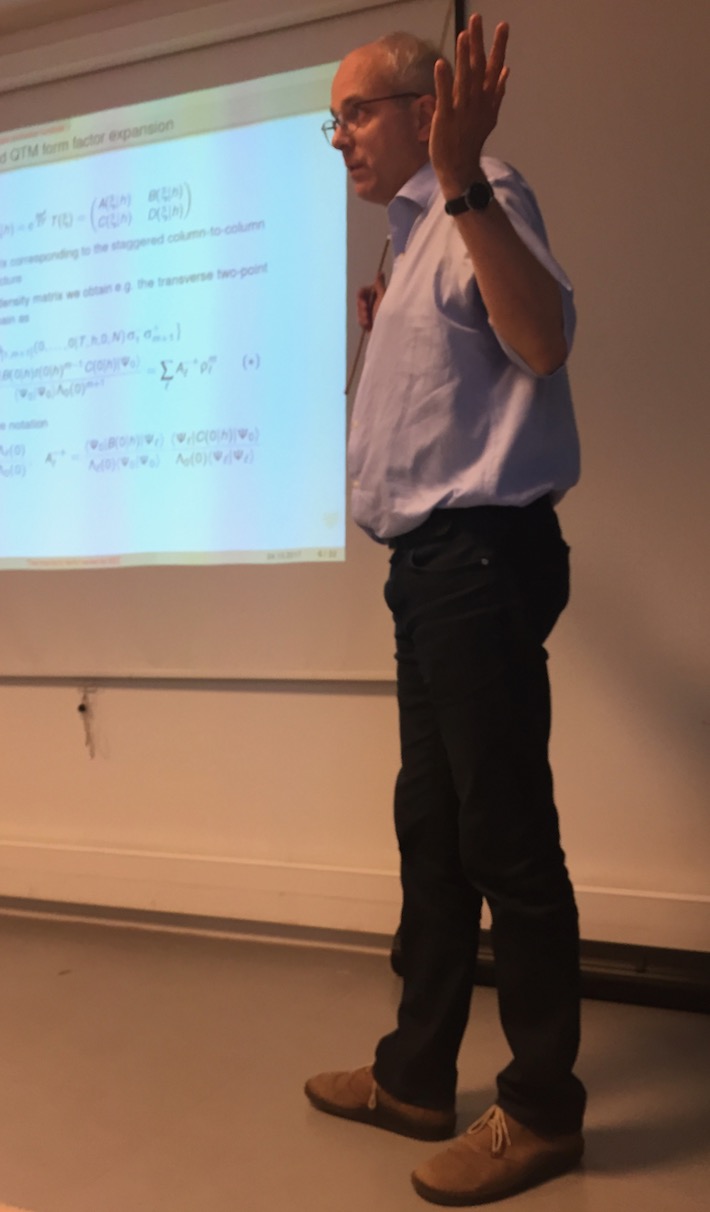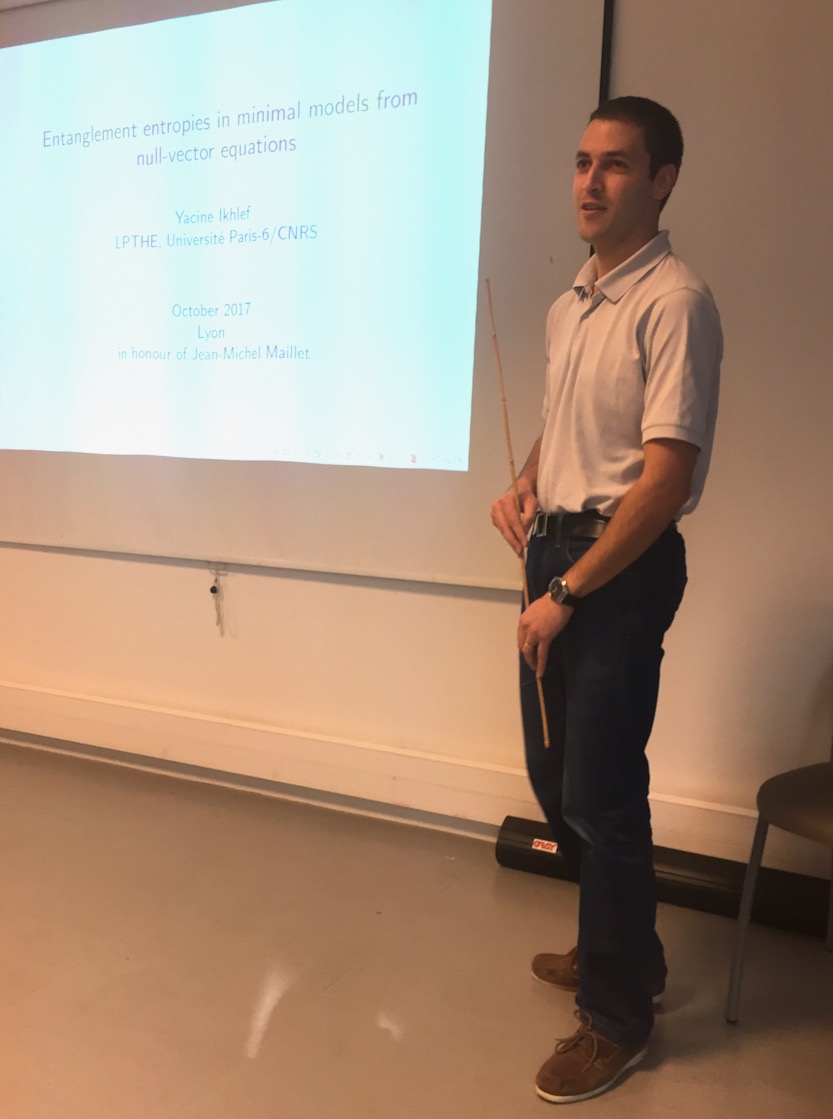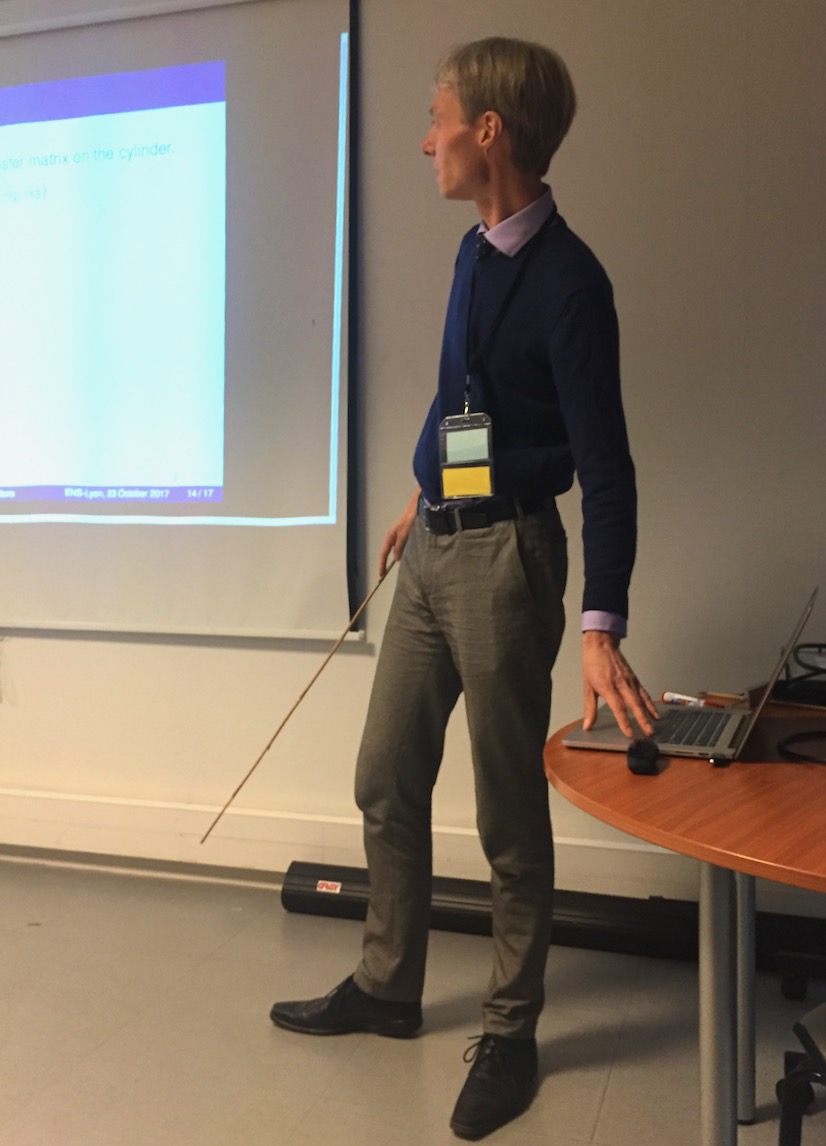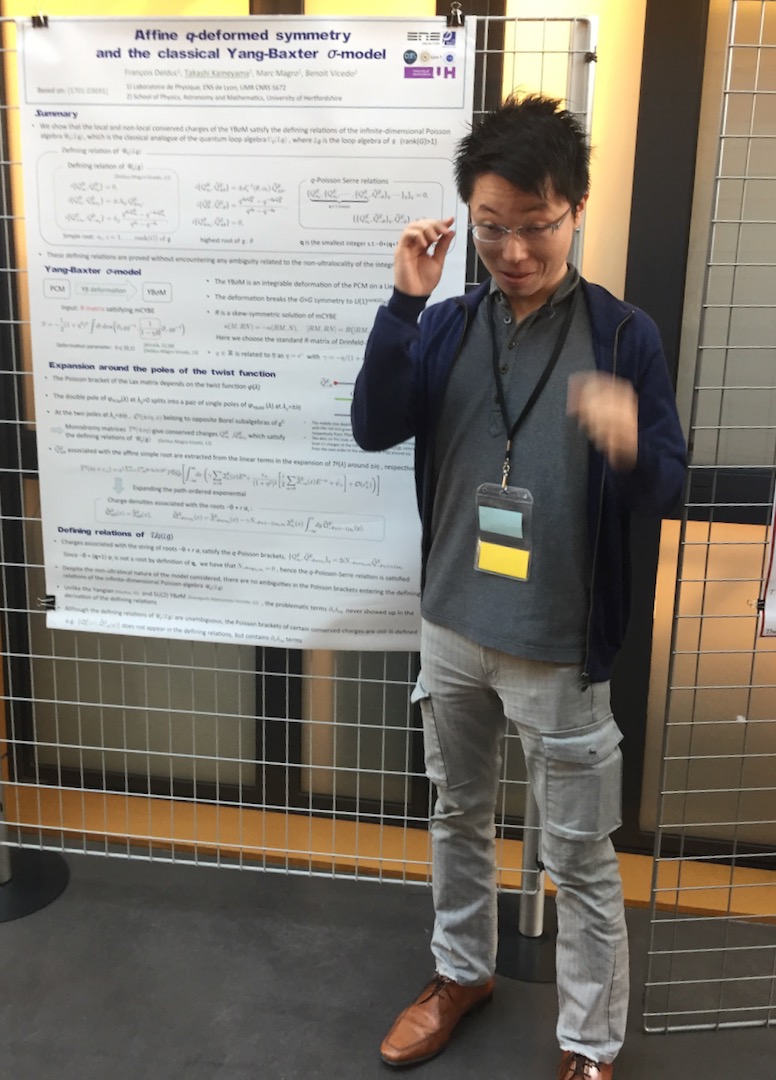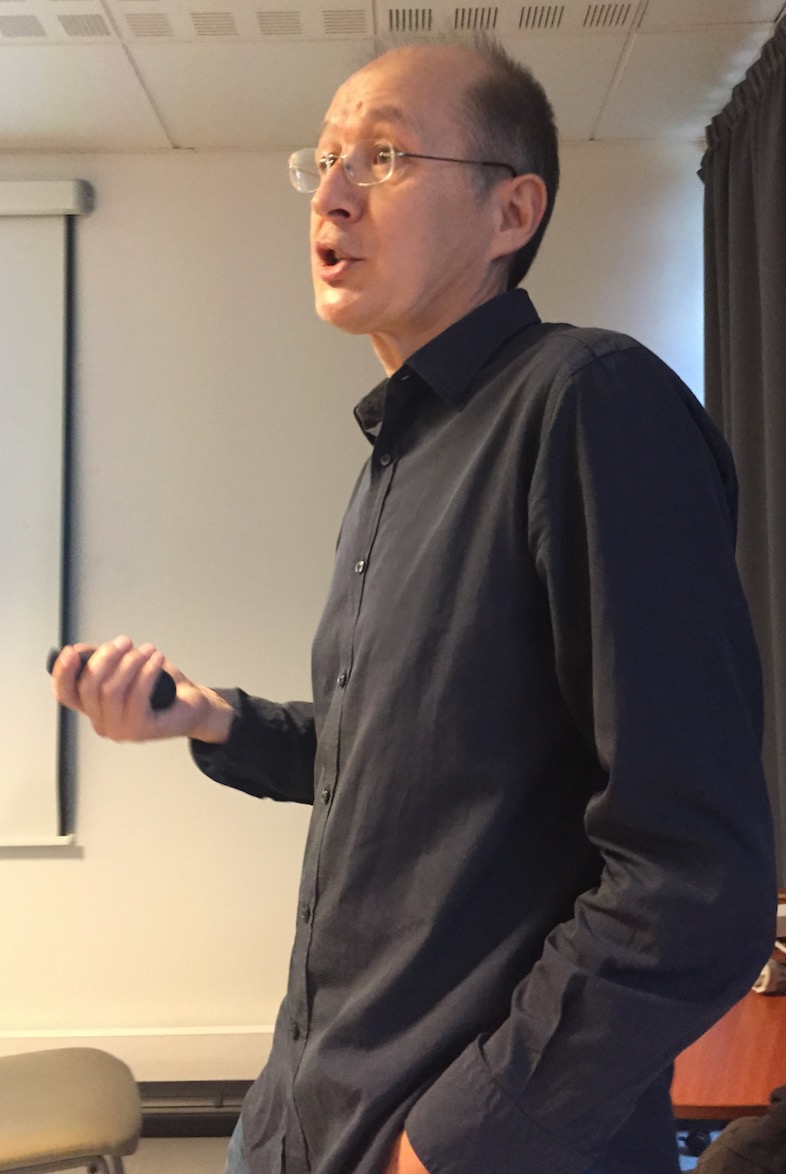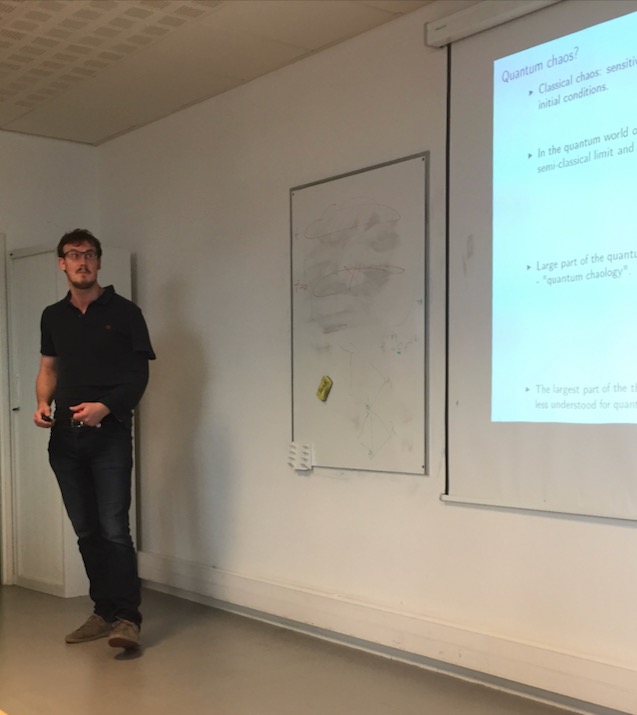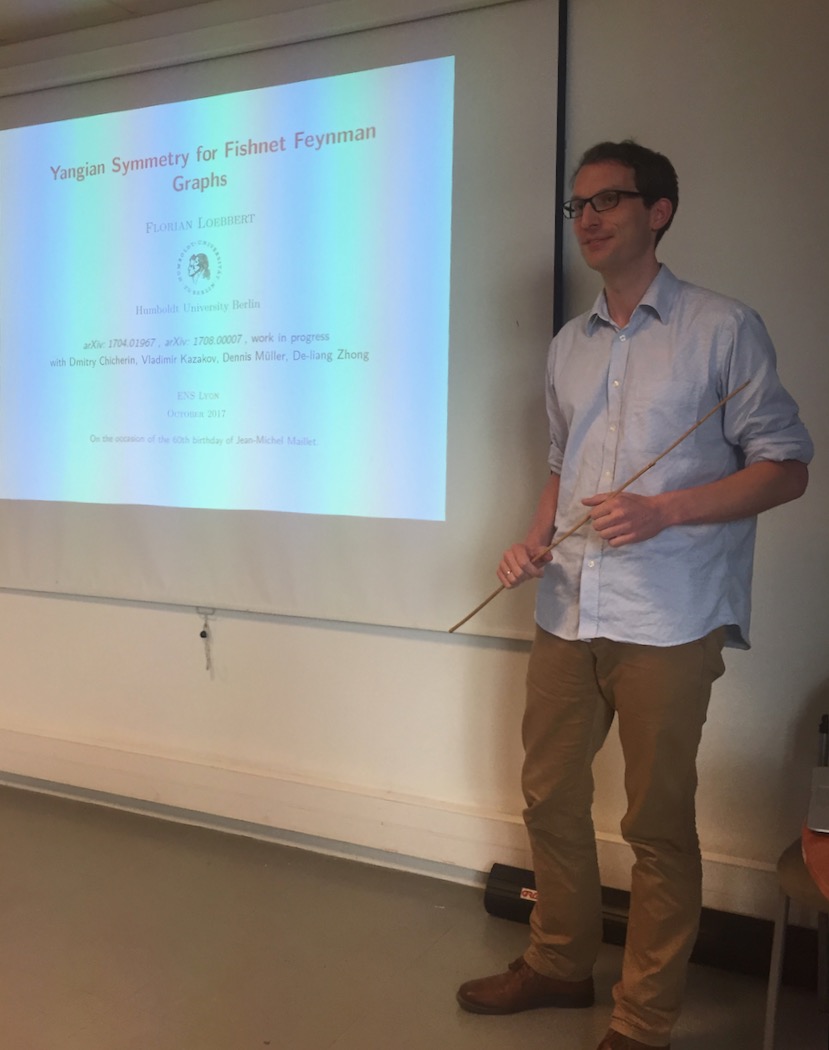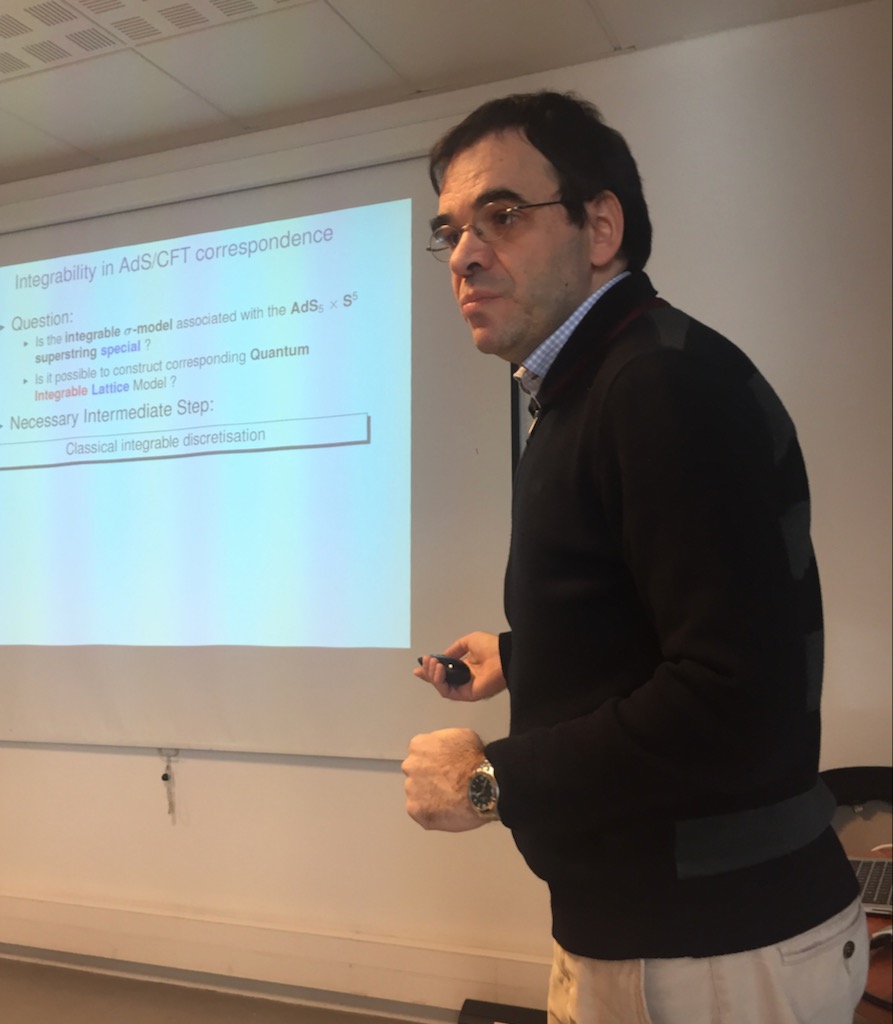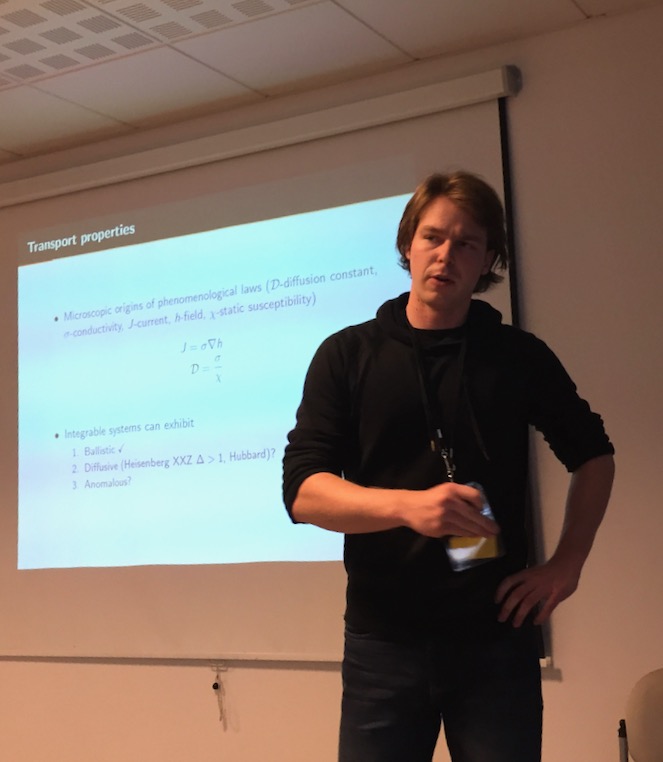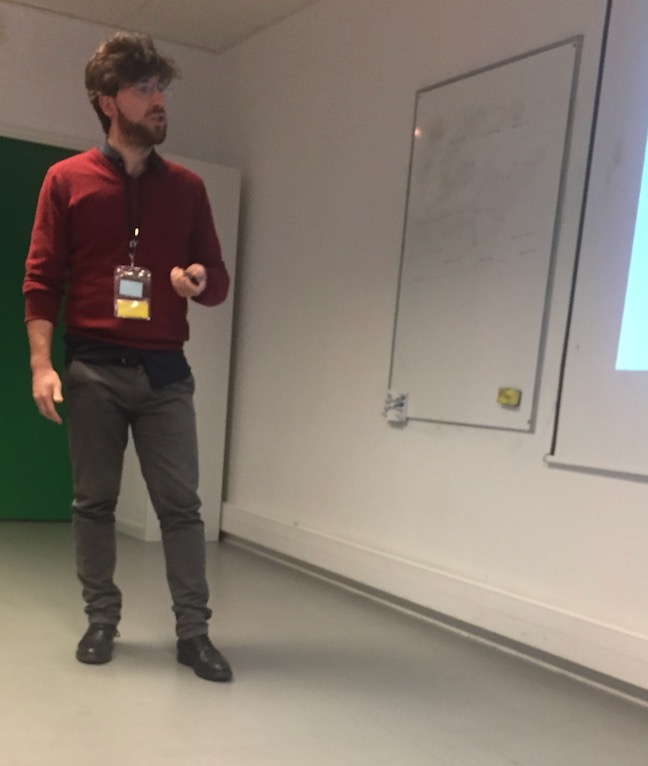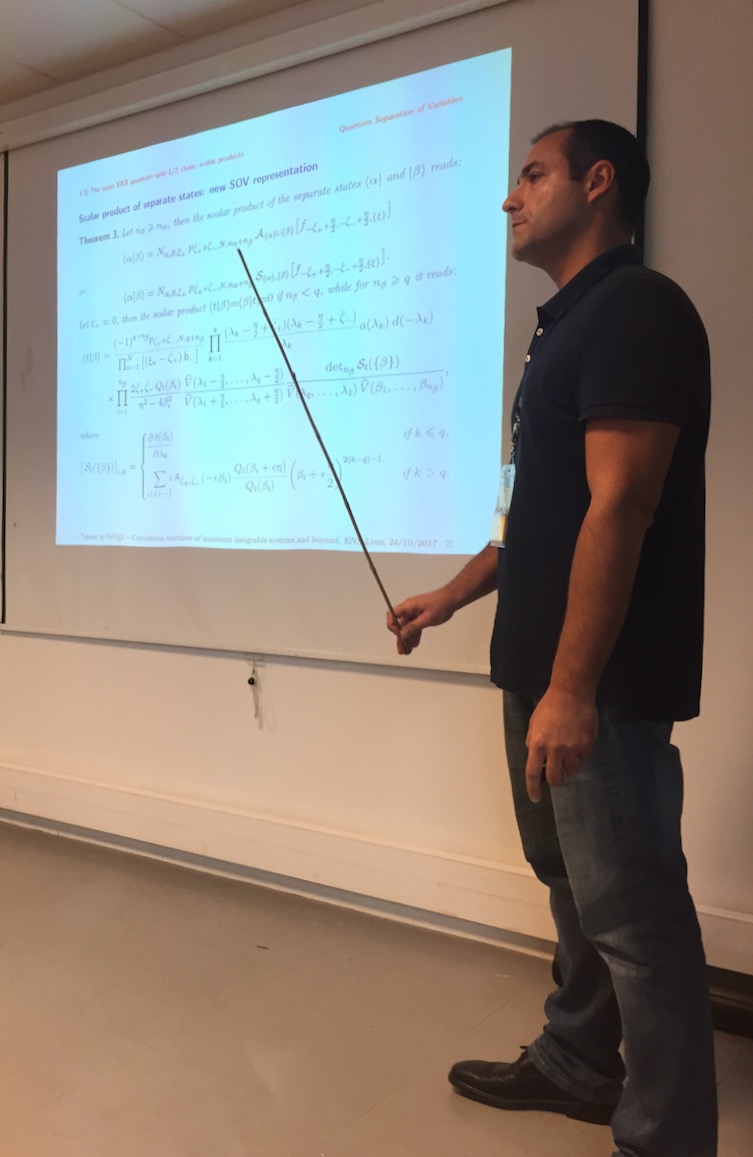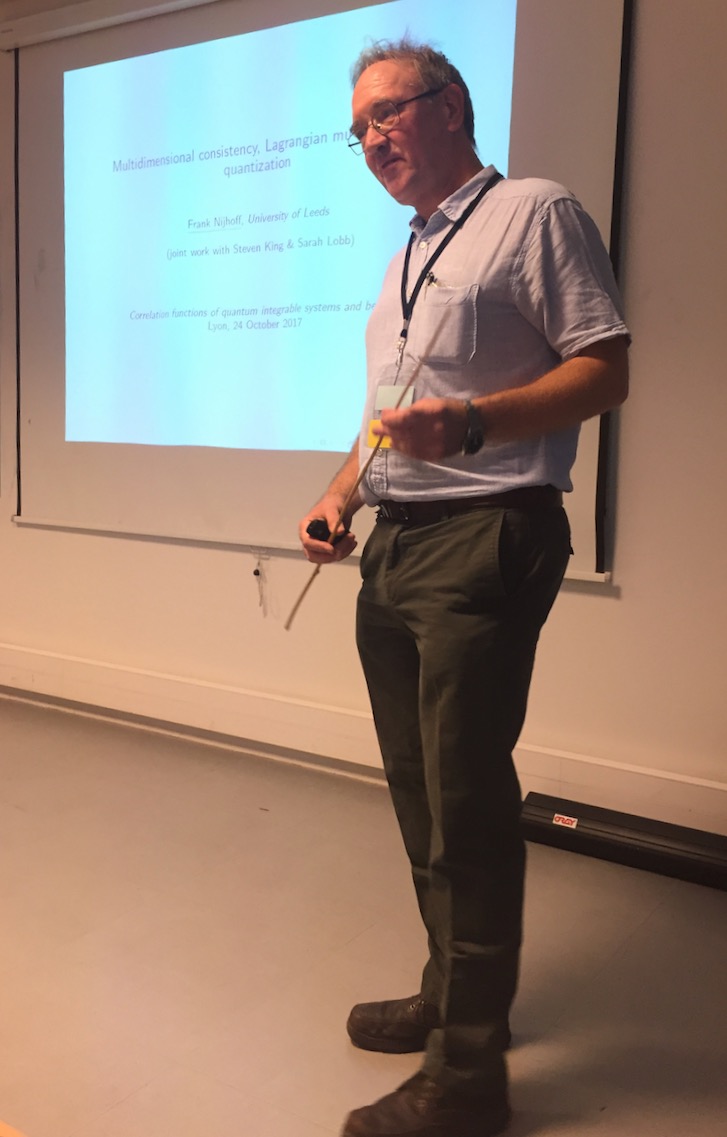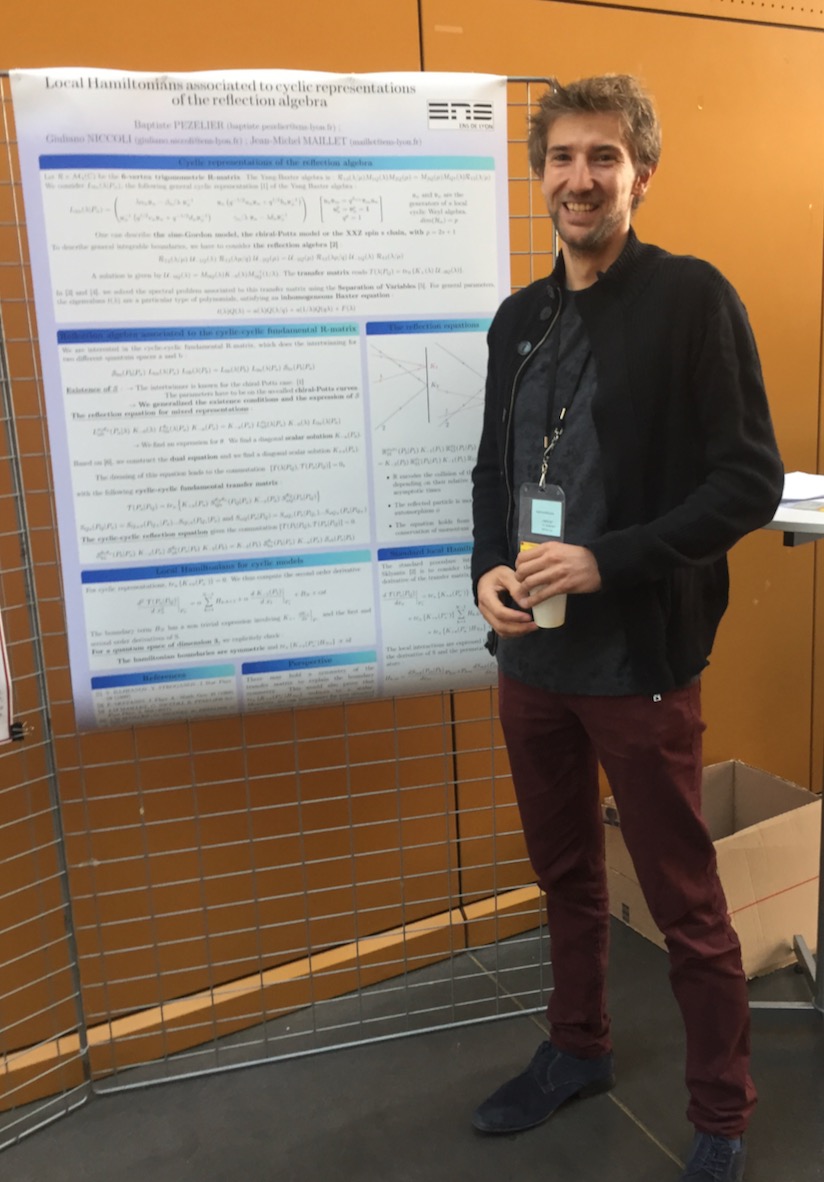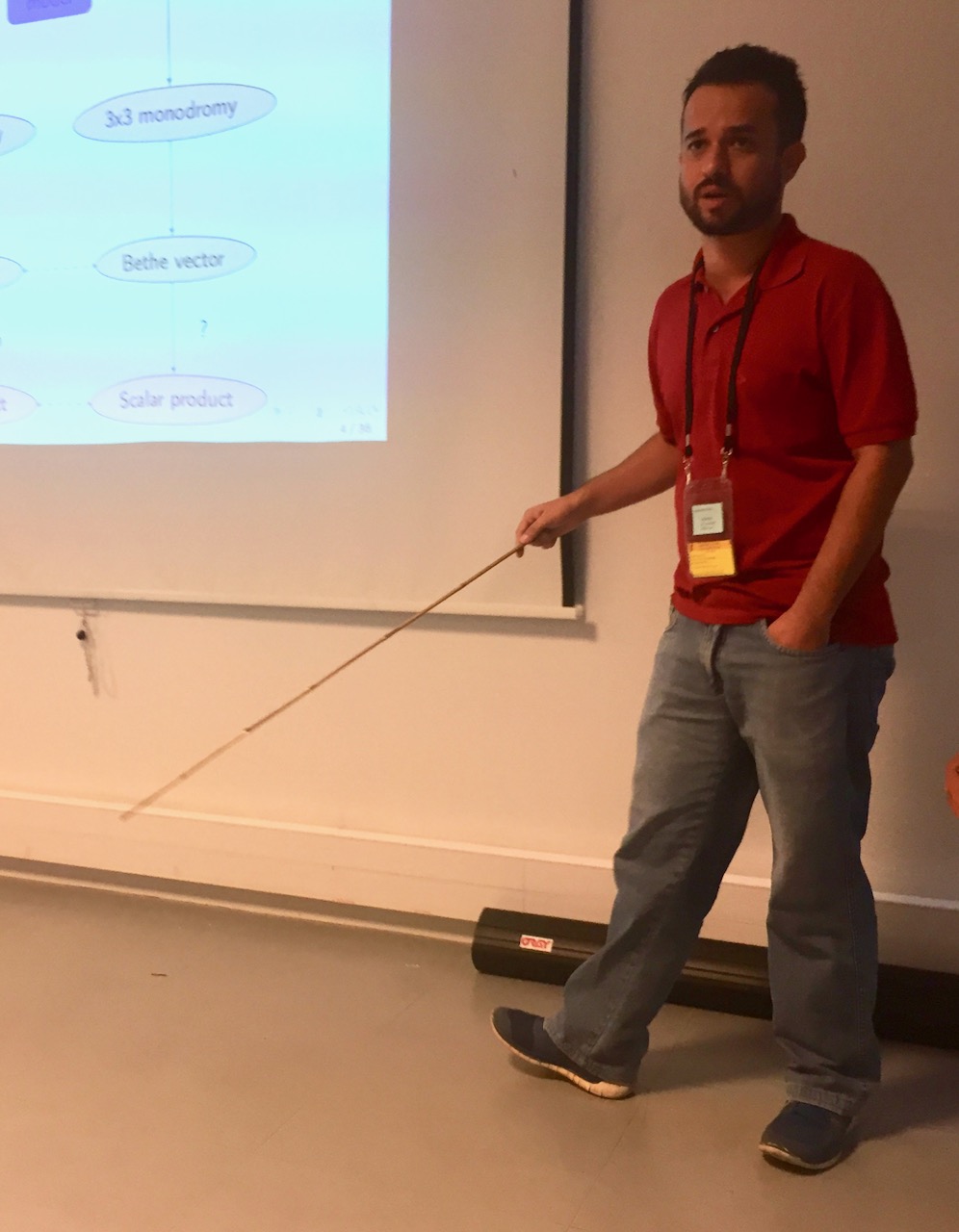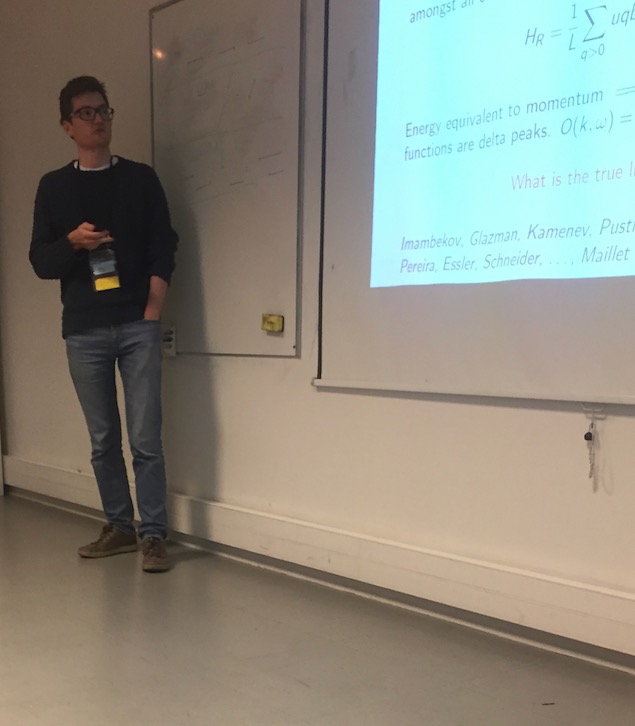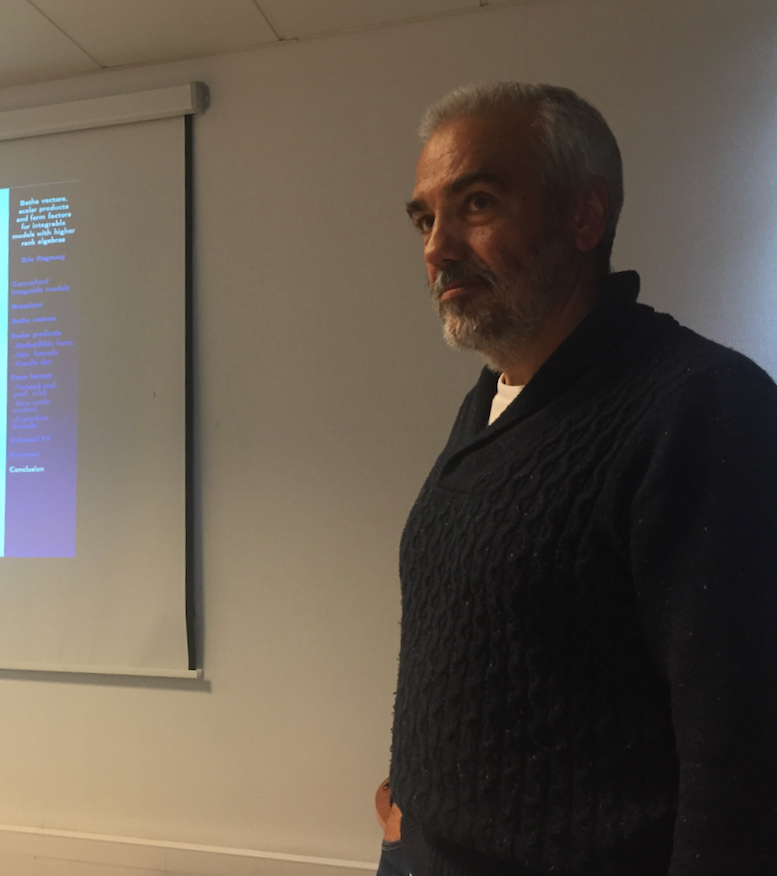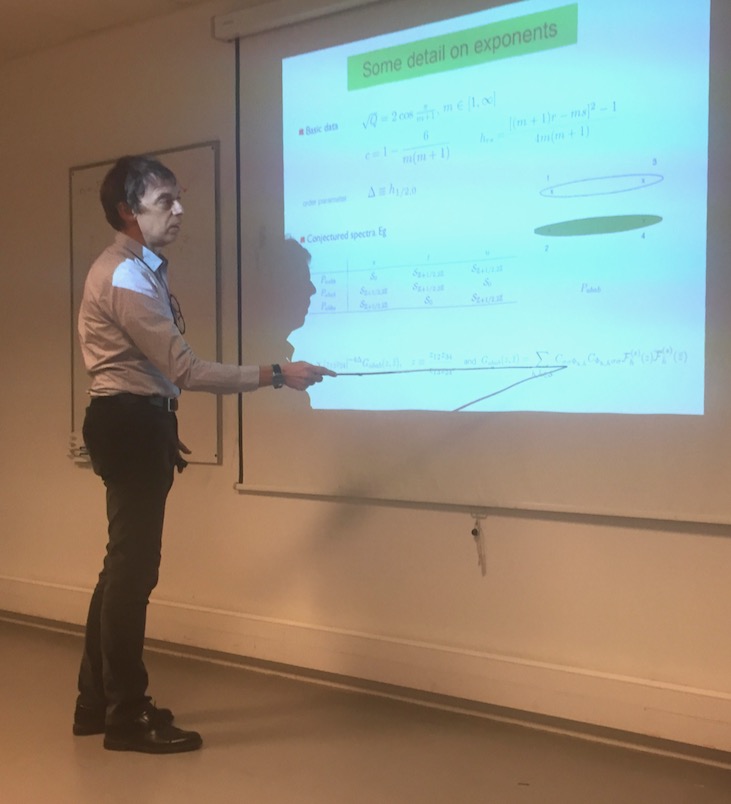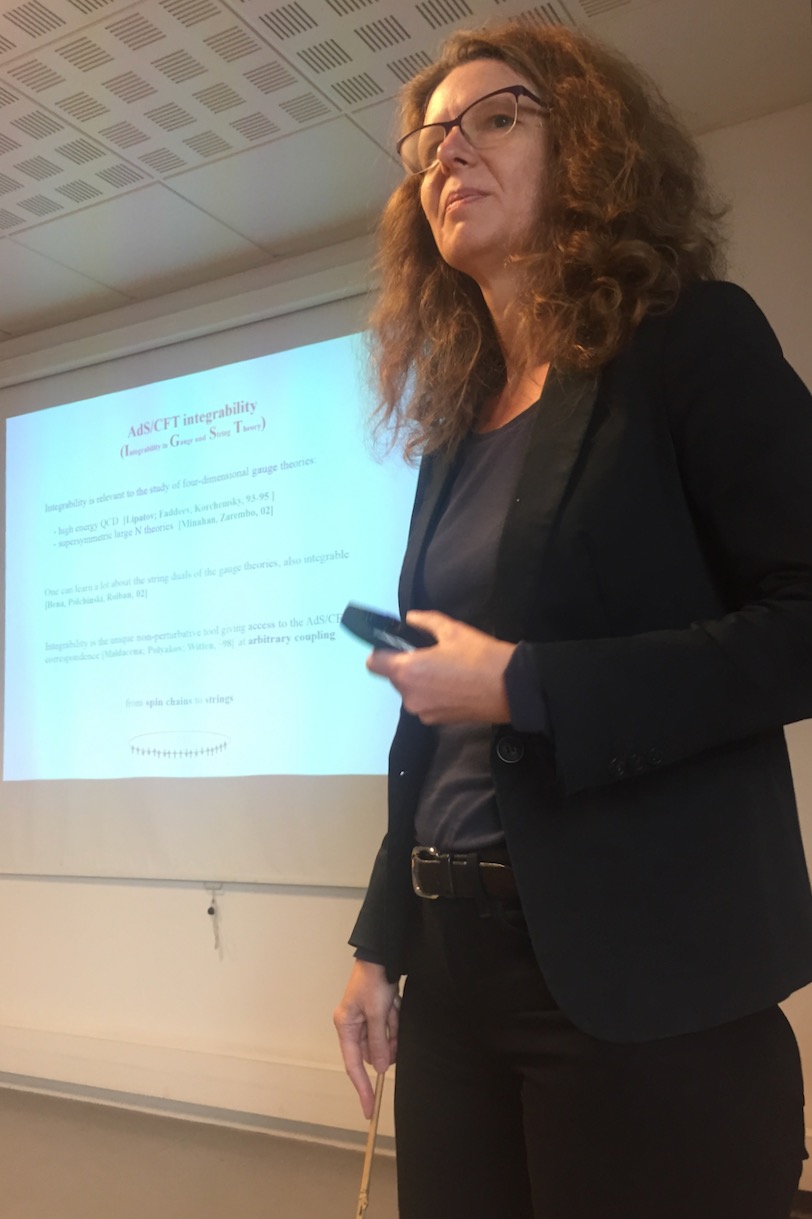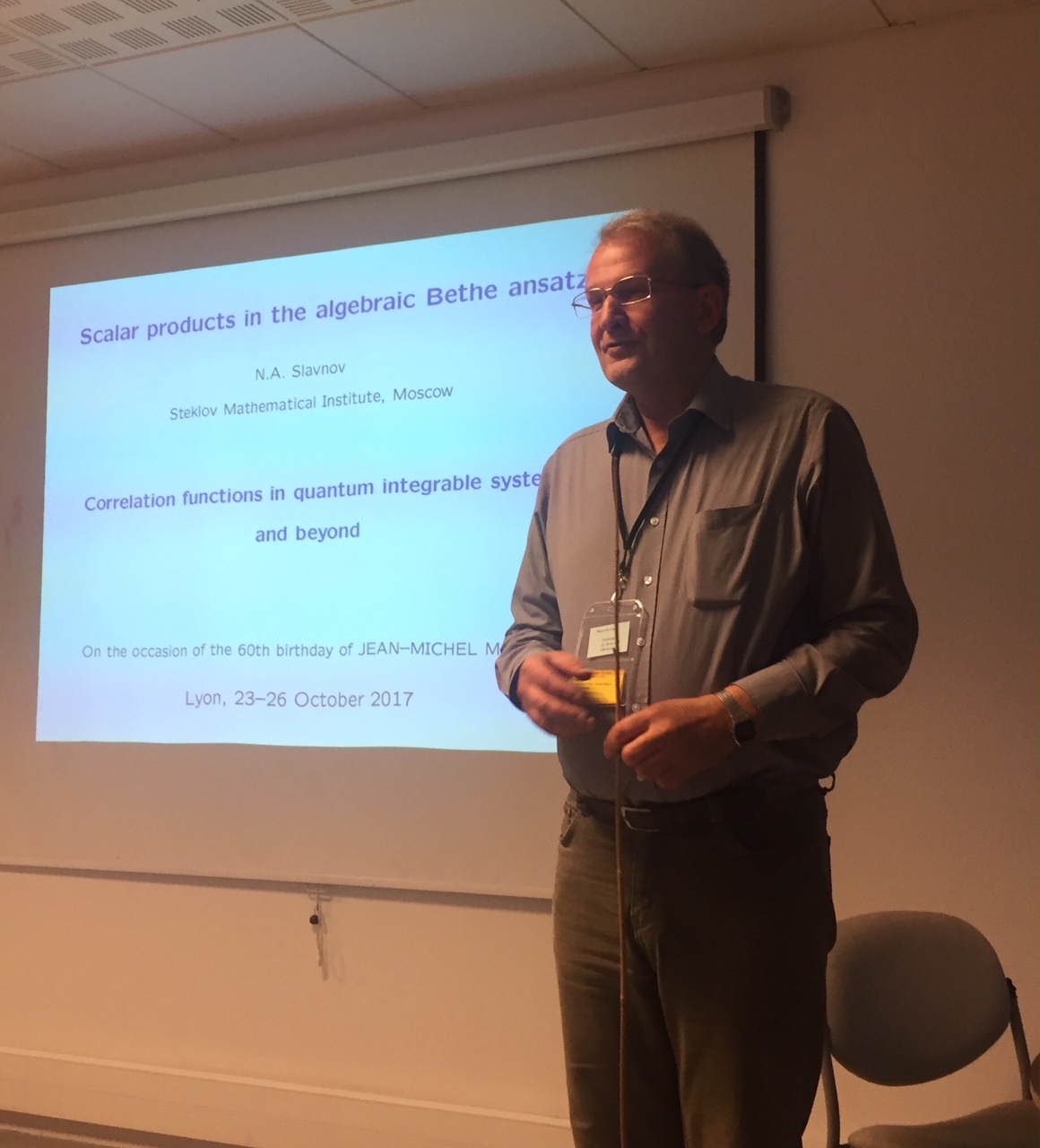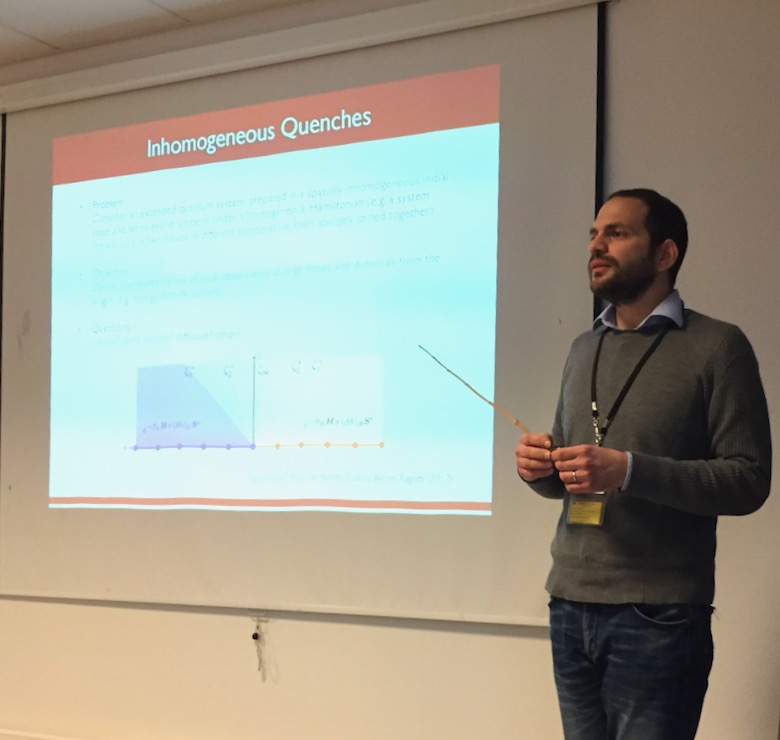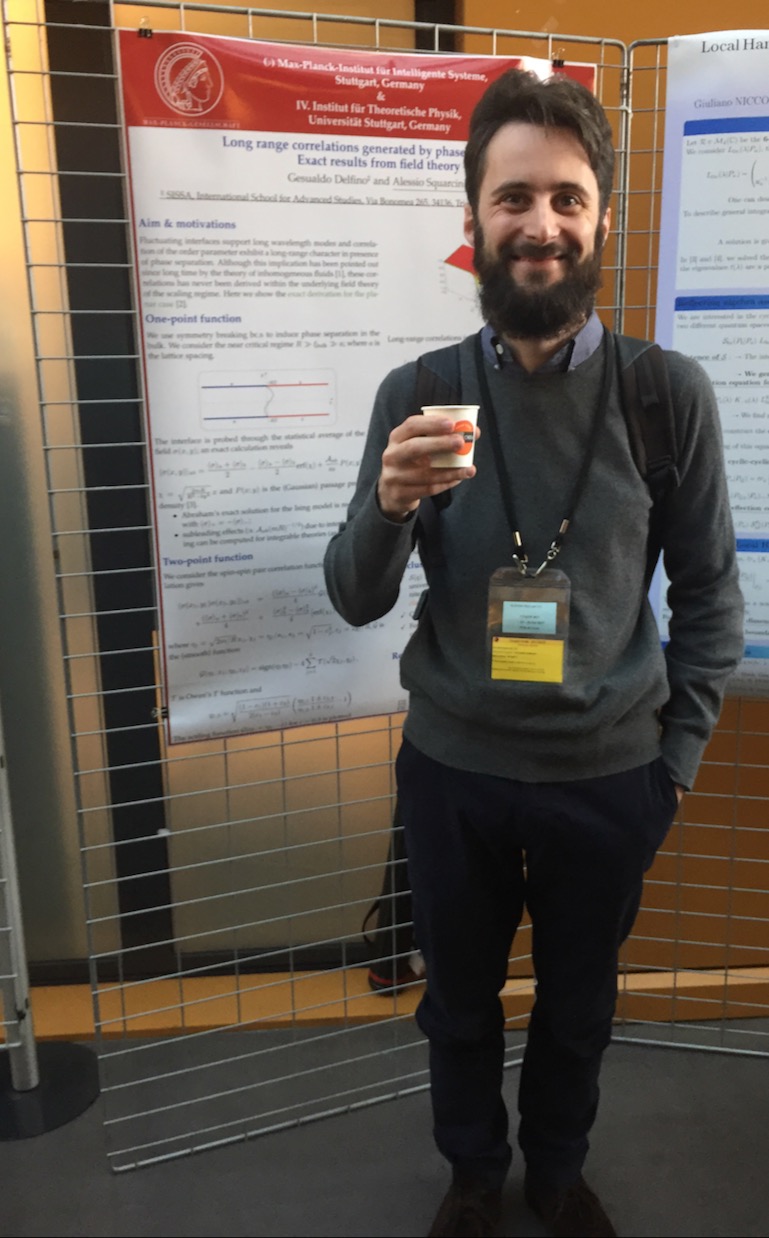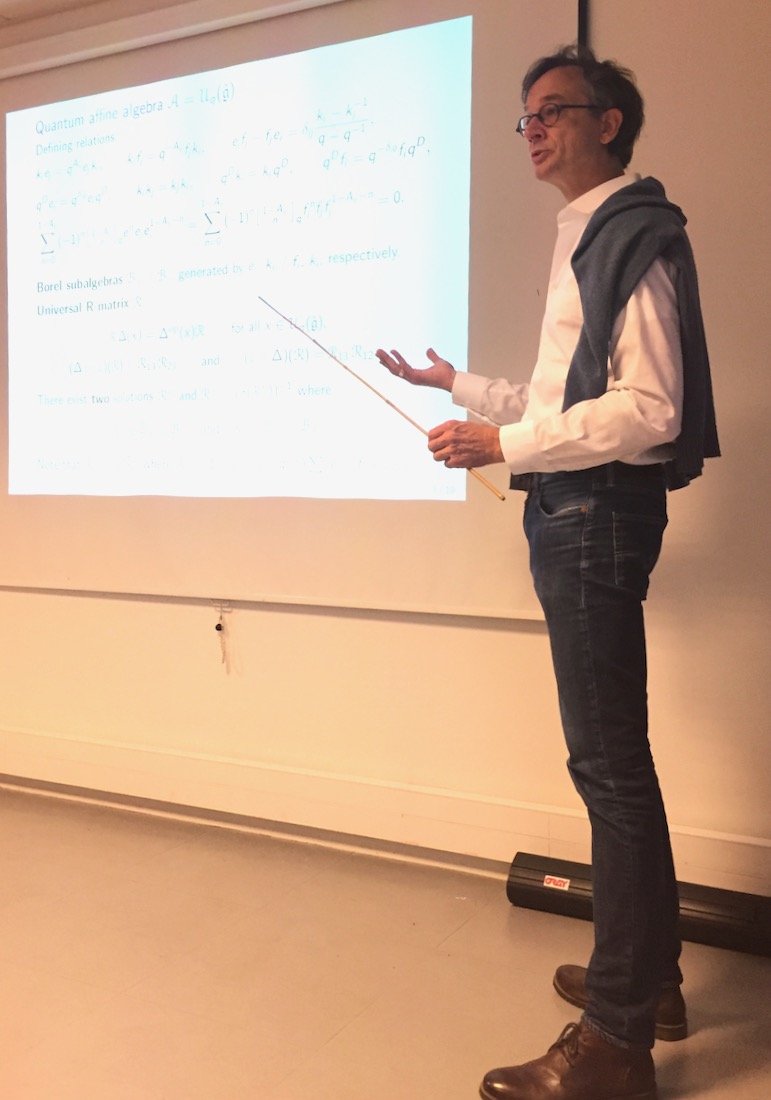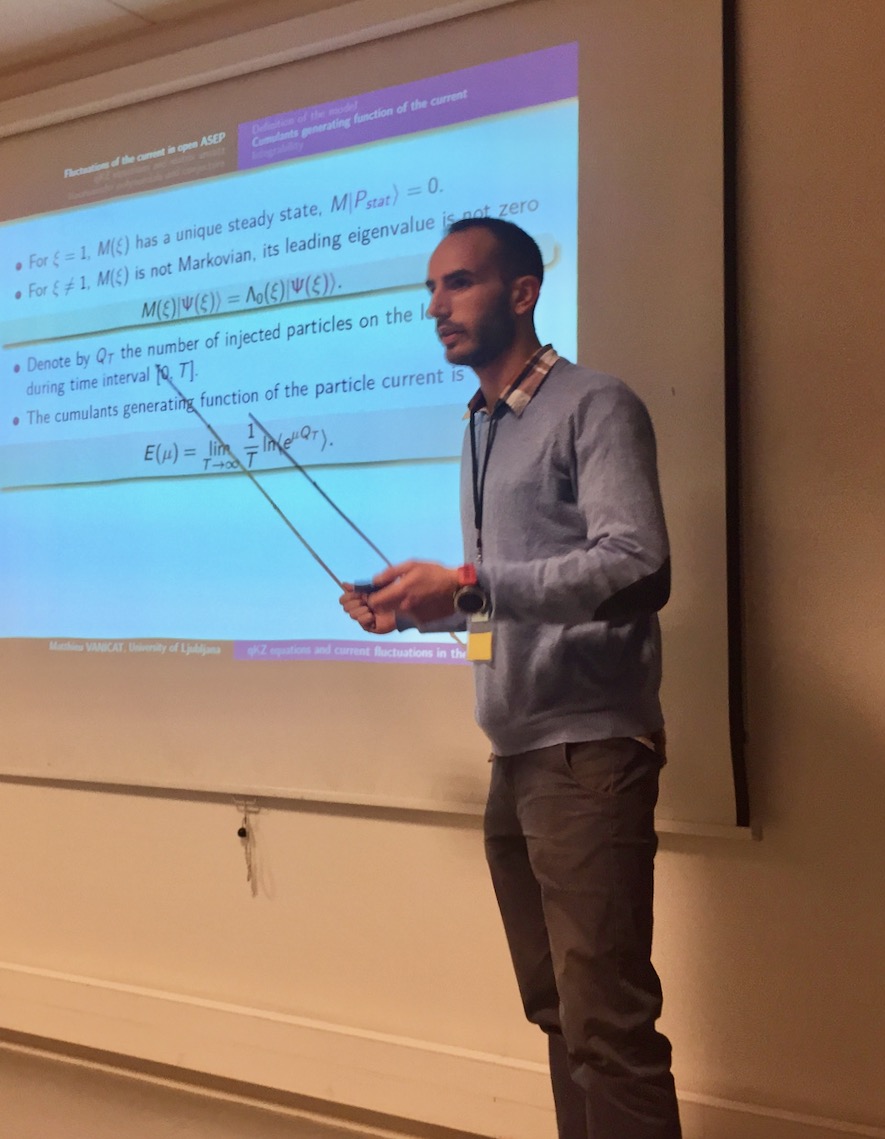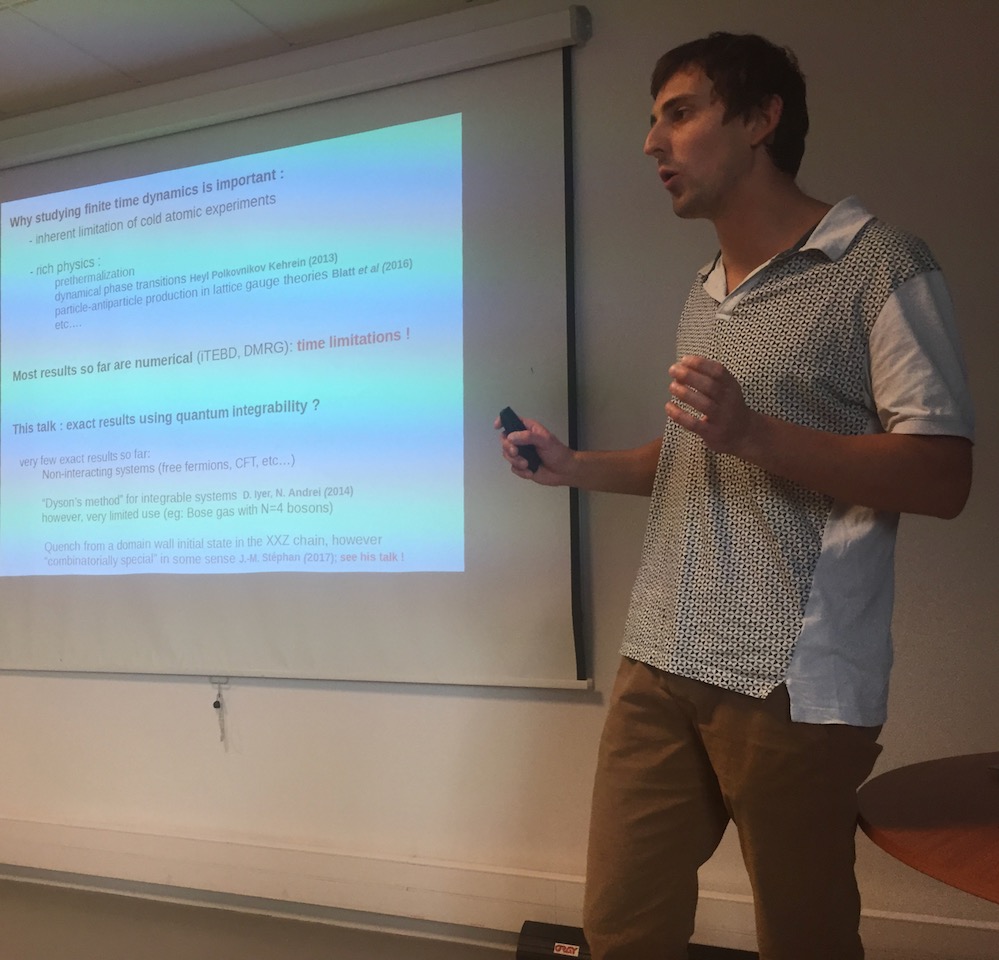|
|
|
Titles and abstractsAVAN Jean Dynamical centers in the elliptic quantum algebra Bq,λ(gl(2))c We identify generating functionals satisfying quadratic exchange relations with the Lax matrices defining the face-type elliptic quantum algebra Bq,λ(gl(2))c. They are built as quadratic trace-like objects in terms of the Lax matrix and occur at the specific values of central charge c = +/-2 . The centrality property inside Bq,λ(gl(2))c is deformed by shifts hence the denomination "dynamical centers". They however generate genuine abelian subalgebras. BABELON Olivier Baxteriology in Toda-2 and q-Toda I will construct Baxter operator for the q-Toda chain and Toda-2 chain (Toda chain in the second Hamiltonian structure). I will sketch the solution of Baxter equation through the Non Linear Integral Equation technique. This is a joint work with Karol Kozlowski and Vincent Pasquier. BOUTTIER Jérémie The free boundary Schur process and applications The Schur process, originally introduced by Okounkov and Reshetikhin, is a random sequence of integer partitions whose transition rates are given by (skew) Schur functions. It is a time-dependent generalization of Okounkov’s Schur measure, and encompasses several combinatorial models such as plane partitions, domino tilings of the Aztec diamond and last-passage percolation (LPP). CAUX Jean-Sébastien Dynamics from integrability: the Dream of Analytical Solutions This talk, in honour of Jean Michel Maillet, will discuss the great efforts expended and substantial progress achieved in applying methods of integrability to the calculation of dynamical observables in exactly-solvable models. Some personal perspectives will be offered on the current status of the field and its future outlook, with an eye on new areas of applicability such as quench dynamics and driven quantum systems. CLAEYS Pieter Correlation functions and inner products in integrable Richardson-Gaudin models We present a general method for the calculation of correlation functions and inner products in Richardson-Gaudin models. These follow from inner products in such models, which can be represented as determinants in several different ways (including the Slavnov determinant). It is shown how these determinant representations are all interconnected and can be expressed in terms of Cauchy matrices. This framework provides a further connection between two different approaches for such integrable models, one in which everything is expressed in terms of rapidities satisfying Bethe equations, and one in which everything is expressed in terms of the eigenvalues of conserved charges, satisfying quadratic equations. CORTES CUBERO Axel Quantum quench in the attractive regime of sine-Gordon We study the dynamics of the sine-Gordon model after a quantum quench into the attractive regime, where the spectrum consists of solitons, antisolitons and breathers. We analyse the time-dependent expectation value of a vertex operator, starting from an initial state which corresponds to integrable boundary conditions. Using an expansion in terms of exact form factors, we compute the leading contributions to this expectation value at late times. Form factors containing breathers only contribute to the late-time dynamics if the initial state exhibits zero-momentum breather states. The leading terms at late times exhibit both, exponential decay and oscillatory behavior, and we compute decay rates and effective frequencies analytically. We compute the low-energy contributions to the power spectrum of the vertex operator, which is shown to have smooth peaks located near the values of the bare breather masses. Our result limits the ideal accuracy of previous quench spectroscopy programs.
DOREY Patrick Breaking integrability at the boundary This talk will describe some surprising aspects of classical boundary scattering in the sine-Gordon model when integrability is broken at the boundary. As a warm-up related phenomena in the φ4 field theory will be described. There will be movies. GÖHMANN Frank Thermal form factors and form factor series for correlation functions of the XXZ chain Correlation functions of Yang-Baxter integrable lattice models can be expanded into form-factor series involving matrix elements of the quantum transfer matrix rather than the usual transfer matrix. This is called the thermal form-factor approach to correlation functions. We have calculated the thermal form factors of local operators for the XXZ chain and have analyzed the corresponding form-factor series in the low-temperature limit. In this talk I review the method, show asymptotic and numerical results for static correlation functions and discuss further perspectives, in particular for the dynamical case. IKHLEF Yacine Entanglement entropies of minimal models from null-vector equations We present a new method to compute Rényi entropies in one-dimensional critical systems. The null-vector conditions on the twist fields in the cyclic orbifold allow us to derive a differential equation for their correlation functions. The latter are then determined by standard bootstrap techniques. We apply this method to the calculation of various Rényi entropies in the non-unitary Yang-Lee model. Joint work with B. Estienne and Th. Dupic JACOBSEN Jesper Three-point functions in c ≤ 1 Liouville theory and conformal loop ensembles The computation of correlation functions of three or more points using the well-known Coulomb gas approach is largely based on charge neutrality and the existence of singular states for Kac operators. However, in geometrical models involving loops and clusters, such as the self-avoiding walk or percolation, interesting correlation functions can be defined for which one or both of these hypotheses fail. For example, what is the probability of having N points on the same loop or inside the same cluster? In this talk we focus on aspects of the N=3 case (the N=4 problem will be discussed in Saleur’s talk). JIMBO Michio Toroidal symmetry in quantum integrable systems Quantum toroidal algebras are a q analog of loop algebras in two independent variables. We consider transfer matrices associated with their R matrix, and explain that the corresponding Hamiltonians coincide with the q deformation of the quantum KdV system introduced earlier by Feigin et al. We describe their spectra in terms of the Bethe ansatz equations. KAMEYAMA Takashi Affine q-deformed symmetry and the classical Yang-Baxter sigma-model The Yang-Baxter sigma-model is an integrable deformation of the principal chiral model on a Lie group G. It is known that the left G-symmetry of this model is q-deformed. For a general Lie group G with rank(G)>1, we extend this previous result by constructing local and non-local conserved charges satisfying all the defining relations of the infinite-dimensional Poisson algebra, which is the classical analogue of the quantum loop algebra. These defining relations are proved without encountering any ambiguity related to the non-ultralocality of this integrable sigma-model. KASHAEV Rinat Spectral equations for the modular oscillator I will talk about the spectral problem for a pair of commuting modular conjugate (in the sense of Faddeev) Harper type operators with complex values of Planck’s constant. The eigenvectors are expressed in terms of a special entire function on the complex plane with the Taylor expansion coefficients given in terms of specific q-orthogonal polynomials, while the eigenvalues are solutions of transcendental Bethe type equations. This is a joint work with Sergey Sergeev. KUKULJAN Ivan Out-of-time-ordered correlators in locally interacting physics Out-of-time-ordered correlation functions (OTOC) have been recently proposed as a nouvelle object to study chaos in strongly interacting quantum many-body systems. The idea was motivated by the renewed interest in the quantum chaos coming from the high energy community, in particular in the domain of the AdS/CFT duality. The proposal soon gained a lot of attention from both the high energy and condensed matter communities. The OTOC are defined as: LISOVYY Oleg Painlevé functions, Fredholm determinants and combinatorics I am going to explain explicit construction of general solutions to isomonodromy equations, with the main focus on the Painlevé VI equation. I will start by deriving Fredholm determinant representation of the Painlevé VI tau function. The corresponding integral operator acts in the direct sum of two copies of L2(S1). Its kernel is expressed in terms of hypergeometric fundamental solutions of two auxiliary 3-point Fuchsian systems whose monodromy is determined by monodromy of the associated linear problem via a decomposition of ℂℙ1\{4 points} into two pairs of pants. In the Fourier basis, this kernel is given by an infinite Cauchy matrix. I am going to show that the principal minor expansion of the Fredholm determinant yields a combinatorial series representation for the general solution to Painlevé VI in the form of a sum over pairs of Young diagrams. LOEBBERT Florian Yangian Symmetry for Fishnet Feynman Graphs We show that various families of fishnet Feynman integrals are invariant under a Yangian over the conformal algebra. This observation comprises scalar triangle, square and hexagon graphs in three, four and six spacetime dimensions, respectively, as well as new types of integrable fishnets including fermions. The Yangian symmetry yields novel differential equations for these largely unsolved classes of integrals. Moreover, the considered fishnet graphs in three and four dimensions correspond to correlation functions and scattering amplitudes in specific double scaling limits of planar, gamma-twisted N=4 super Yang-Mills or ABJM theory. These limits define integrable quantum field theories in four and three spacetime dimensions and open the door to understanding the origins of AdS/CFT integrability. MAGRO Marc Back to the future ! I shall review results on the study of integrable-sigma models, such as the principal chiral model, in light of the recent developments on their integrable deformations. This review will enable us to enjoy travelling back in time, in particular to years 1985 and 1991. McCOY Barry Understanding versus Ignorance: Integrability, differential equations, zeros, universality I will discuss four problems concerning the Ising model: MEDENJAK Marko On diffusion in integrable systems Out-of-equilibrium properties are one of the central interests in the study of many-body systems. As a consequence of local conservation laws, integrable systems typically exhibit ballistic transport. However, in certain cases appropriate conservation laws might be absent, raising the question about the nature of the transport. In my talk I will present two results on the topic. The first one establishes the connection between the diffusion constant and the ideal transport coefficient, the Drude weight. This result is used to calculate the lower bound on diffusion constant in anisotropic Heisenberg model. In the second part I will deal with the classical deterministic cellular automaton, describing the dynamics of charged, hard-core interacting particles. Besides the ballistic and insulating regime, the model, surprisingly, exhibits diffusive transport for certain values of parameters. The toy model offers the insight in possible generic mechanism behind the diffusion in integrable systems, which can be viewed as an interplay between the insulating behavior of charged particles and the ballistic nature of neutral degrees of freedom. DE NARDIS Jacopo Density-density correlation functions of the one-dimensional Bose gas, generalized detailed balance and hydrodynamics I will present some recent analytical results on the thermal and non-thermal correlation functions of the density operator (Dynamical Structure Factor) in the Lieb-Liniger model. I will show that at small momenta this can be written in terms of a single sum over particle-hole excitations. I will focus mostly on the one-dimensional Bose gas even if similar results are expected to hold for any integrable model. This result implies a generalized detailed balance expression valid for a generic generalized Gibbs ensemble and it can be used to experimentally extract the generalized temperatures of the system. Finally I will quickly review the recently introduced "generalized hydrodynamics theory" and how this can be used to compute the Drude weights of any integrable model. NICCOLI Giuliano Quantum separation of variables from the spectrum to the matrix elements of local operators of integrable quantum models I will describe the method of quantum separation of variables (SoV), first introduced by Sklyanin, for the analysis of the spectrum of integrable quantum model. SoV can be applied to a large class of integrable quantum models, not analyzable by other methods, and it has as a fundamental built-in feature the completeness of the spectrum description. I will describe how to implement it for integrable quantum models associated to both Yang-Baxter and Reflections algebras. Then, I will focus on the problem to characterize the quantum dynamics in the SOV framework. Here, our first main result is the universality of the representation of scalar products and matrix elements of local operators by determinant formulae. Our second main result is the proof that these formulae admit rewriting similar to those appearing in the context of algebraic Bethe ansatz, like Izergin’s and Slavnov’s determinants. These representations are of particular interest as they provide the natural framework to implement the analysis of their homogeneous and thermodynamic limits. NIJHOFF Frank Multidimensional consistency, Lagrangian multi-forms and quantization A notion of integrability on the space-time lattice is that of multidimensional consistency, which classically implies the coexistence of commuting discrete dynamics in several (possibly infinitely many) variables imposable on one and the same dependent field variable. Recently a novel variational principle was introduced to capture this phenomenon within a Lagrangian framework, namely that of Lagrangian multi-forms. These structures can also be extended to the continuum. We will review some of the classical results and propose a quantum analogue of this theory in terms of quantum mechanical propagators. PASQUIER Vincent Perturbative Toda Chain I shall present a common work with Olivier Babelon et Karol Kozlowski about the resolution of the Bethe equations of the Toda chain. I will introduce a perturbative way to solve the TQ equations which I shall illustrate with the N=2 spectrum of the q-Toda chain in the strong coupling and unitary cases. PEZELIER Baptiste Local Hamiltonians associated to cyclic representations of the reflection algebra We recently completely characterized both the eigenvalues and the eigenstates of the transfer matrix associated to cyclic representations of the reflection algebra for general integrable boundaries. Here, we construct the reflection algebra associated to the cyclic-cyclic fundamental R-matrix. We find diagonal scalar solutions K for it and compute the local Hamiltonians associated to these integrable boundaries. Particular cases of these models are the XXZ spin s chain, the sine-Gordon model or the chiral-Potts model with integrable boundaries. PIMENTA Rodrigo Scalar products for the Zamolodchikov-Fateev model We revisit the construction of the eigenvectors of the single and double-row transfer matrices associated with the Zamolodchikov-Fateev model, within the algebraic Bethe ansatz method. The left and right eigenvectors are constructed using two different methods: the fusion technique and the Tarasov’s construction. A simple explicit relation between them is obtained. As a consequence, we obtain the Slavnov formula for the scalar product between on-shell and off-shell Tarasov-Bethe vectors. PRICE Tom Fredholm determinants and long time asymptotics for the nonlinear Luttinger liquid at nonzero temperature I will present recent results for the thermal correlation function of vertex operators where time evolution is driven by dispersive free fermions, the Imambekov–Glazman ”nonlinear Luttinger liquid”. By expressing the correlator as a Fredholm determinant I find the long time asymptotics from the steepest descent solution to the associated Riemann–Hilbert problem. At zero temperature the results agree with the mobile impurity asymptotics, but show exponentially small corrections to the mobile impurity phenomenology at finite temperature. RAGOUCY Eric Integrable models: their Bethe vectors, scalar products and form factors We apply the nested algebraic Bethe ansatz to integrable models based on algebras with rank higher than 2. We present some explicit representations for the Bethe vectors and their scalar products, in the framework of periodic generalized models, that encompass all integrable spin chain models with (twisted) periodic boundary conditions. We review what has been (or can be) done, depending on the algebra which underlies the model (Yangian, super-Yangian or quantum group). Starting from these formulas we present some general methods that allow to deduce the form factors of the models. They are essentially of two types: the twisted scalar product and the zero modes method. ROSCILDE Tommaso Quantum correlations at finite temperature: entanglement and beyond In quantum many-body systems correlation properties at finite temperature have both a thermal as well as a quantum origin: the first one stems from incoherent state-to-state fluctuations; while the second one is to be ascribed to the quantum uncertainty of observables not commuting with the Hamiltonian, and their spatial correlations. Here we shall present a systematic way to disentangle the thermal and quantum contributions within a statistical physics framework - the quantum part of correlations (or quantum correlations in short) turns out to be generically short-ranged at finite temperatures, manifesting a novel emergent length, which we dub quantum coherence length. Moreover quantum correlations offer a criterion to detect entanglement (namely inseparability) in the mixed state of the system, which is of direct applicability to both state-of-the-art analytical/numerical calculations of equilibrium quantum many-body systems, as well as to experiments. SALEUR Hubert Four point geometrical correlations in the Potts model I will discuss four point geometrical correlations in the two dimensional critical Potts model using conformal bootstrap ideas as well as algebraic techniques and numerical calculations. This talk will complement and continue Jacobsen’s talk on three point functions in Loop models and Liouville at c<1 SERBAN Didina Correlation functions in N=4 SYM from integrability The talk will review the computation of the three point function of gauge-invariant operators in the planar N=4 SYM theory using integrability-based methods. A recent proposal by Basso, Komatsu and Vieira decomposes the structure constants in terms of two form-factor-like objects (hexagons). Re-summing the contribution implied by the hexagon decomposition into compact expressions is the main challenge of the approach. I will explain how this can be done in the large-charge limit, and compare with the results obtained by semiclassics. SLAVNOV Nikita Scalar products of Bethe vectors in the algebraic Bethe ansatz We consider a problem of Bethe vectors scalar products of the models solvable by the (nested) algebraic Bethe ansatz. For the models with gl(2) symmetry or its q-deformation, the scalar products can be calculated straightforwardly via the standard arguments of the algebraic Bethe ansatz. However, for the models with higher rank symmetry, the technical complexity of such a calculation increases immensely. We suggest a new method based on the coproduct properties of the Bethe vectors. We illustrate this method by the example of the scalar products in the gl(2) based models. SOTIRIADIS Spyros Quantum Transport after Inhomogeneous Quenches in Integrable Models We study quantum dynamics and transport properties of integrable models that are initially split in two halves lying at different temperature or particle density and abruptly connected. Under such inhomogeneous out-of-equilibrium settings, a Non-Equilibrium Steady State (NESS) forms in the thermodynamic a nd large time limit, which has been recently conjectured to be described by a Generalised Hydrodynamic (GHD) approach. Focusing on the expansion of a Lieb-Liniger gas, we show that certain predictions of this conjecture can be derived analytically from the properties of the Slavnov formula for the overlaps between Bethe states. SQUARCINI Alessio Phase separation and interface structure in two dimensions - Exact results from field theory We consider near-critical planar systems with boundary conditions inducing phase separation. While order parameter correlations decay exponentially in pure phases, we show by direct field theoretical derivation how phase separation generates long range correlations in the direction parallel to the interface, and determine their exact analytic form. The latter leads to specific contributions to the structure factor of the interface. STEPHAN Jean-Marie Inhomogeneous quantum quenches in the XXZ chain via six-vertex model with domain wall boundary conditions I consider the unitary dynamics of a spin-1/2 XXZ chain prepared in a strongly inhomogeneous domain wall product state, where all spins on the real negative (positive) line are up (down). I explain how this "quantum quench" problem is related to the six-vertex model by analytic continuation, and how quantum inverse scattering methods on the six-vertex side may be exploited to both derive exact results and gain some insights on such inhomogeneous quenches. I focus in this talk on the simplest quantity, the Izergin-Korepin partition function of the classical model, which becomes a return probability (RP) after the quench, and may be expressed in the form of a Fredholm determinant. In the gapless regime, the decay of the RP at late times is found to be gaussian, with a rate that is, surprisingly, nowhere continuous as a function of anisotropy. Exactly at the Heisenberg point, the decay is exponential in √t, strongly suggesting diffusive transport. This particular quench also serves as an opportunity to discuss alternative approaches such as the generalized hydrodynamic treatment of integrable systems, or closely related problems such as arctic curves for classical dimer coverings, and conformal field theory description of 1d inhomogeneous systems. TESCHNER Jörg Putting generalised Toda QFT on the lattice We describe a strategy to construct integrable lattice regularisations of a class of integrable field theories of generalised Toda type. The interaction terms in the Lagrangian determine the quantum affine (super-) algebras responsible for the integrability of the theory. All the main ingredients of the lattice regularisation (Lax matrices, T- and Q- operators) are obtained by applying suitable representations to the universal R-matrix of the relevant quantum affine (super-) algebra. A key feature of the proposal is a direct relation between lattice light-cone directions and the Borel subalgebras of the quantum affine (super-) algebra. VANICAT Matthieu Matrix product construction for Koornwinder polynomials and fluctuations of the current in the open ASEP Starting from the current-counting deformation of the Markov matrix for the open boundary ASEP, we prove that with a further deformation, Koornwinder polynomials appear as the normalisation of the twice deformed ground state. We give a matrix product construction for this ground state and the corresponding Koornwinder polynomials. Based on the form of this construction and numerical evidence, we conjecture a relation between the generating function of the cumulants of the current, and a certain limit of the Koornwinder polynomials. VERNIER Eric Exact results for the non-equilibrium dynamics of quantum integrable models In this talk I will present a framework for computing exactly the out-of-equilibrium dynamics of physical observables in quantum integrable models. The protocol used to drive the system out of equilibrium is the paradigmatic one of a "quantum quench", which consists in preparing the system in some initial state at time t=0 and letting it evolve unitarily for t>0. Starting with some prototypical initial states in the XXZ spin chain, I will show how to compute exactly the time evolution of the so-called Loschmidt echo (or return rate), which measures the overlap between the system's state at time t and its initial state. This observable has recently attracted a renewed interest in the context of "dynamical phase transitions" which it signals through its singularities as a function of time. I will show how our approach indeed allows to observe and study such transitions analytically. The extension of this approach to the study of other observables such as local correlators will also be discussed. |



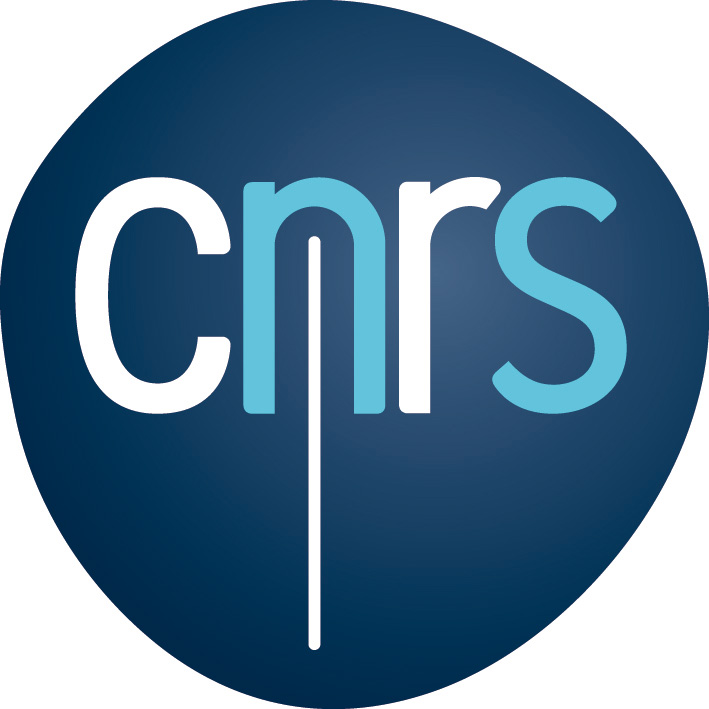
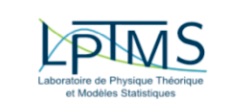


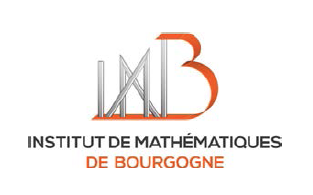
 PDF
PDF 
